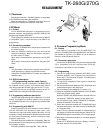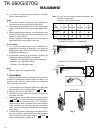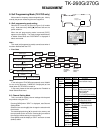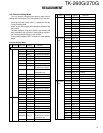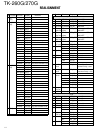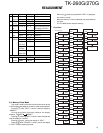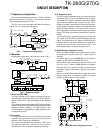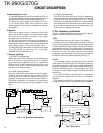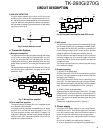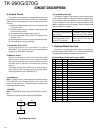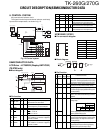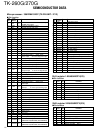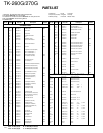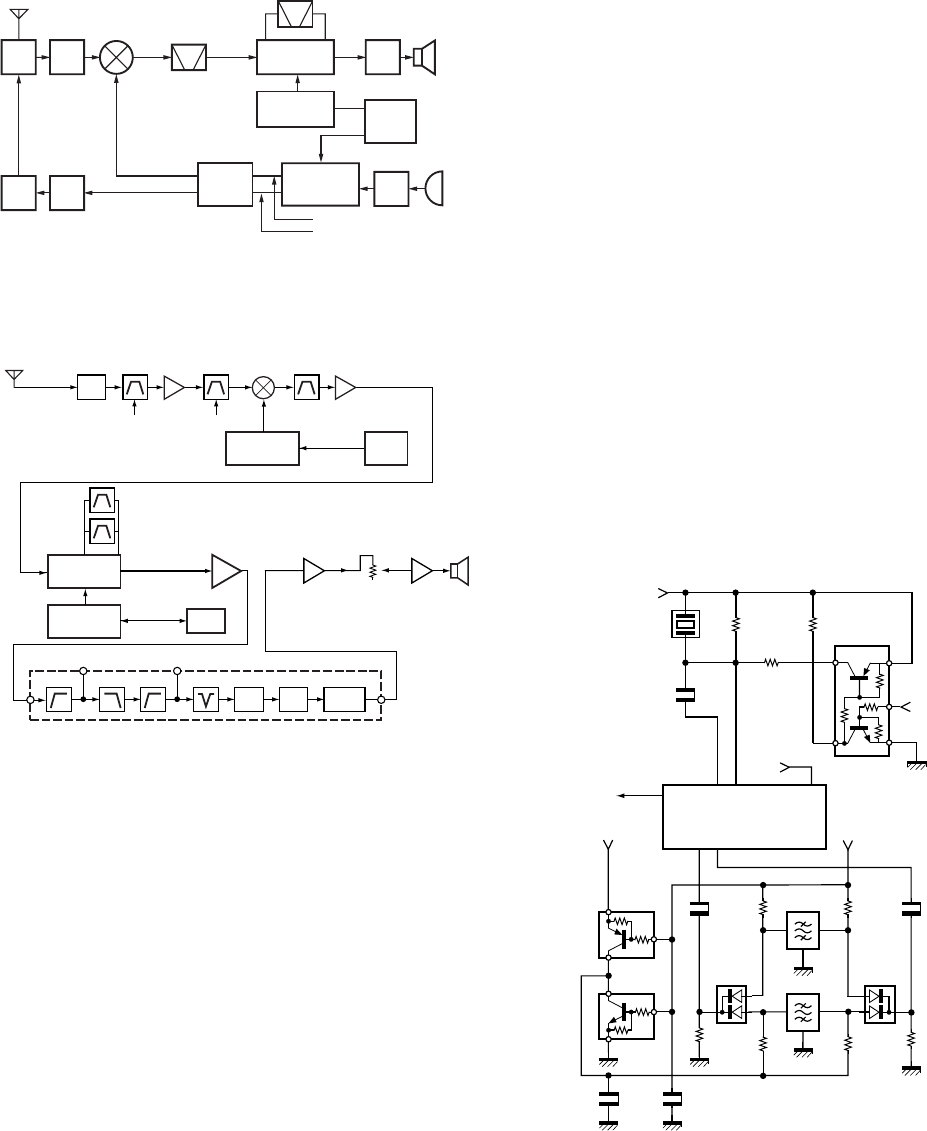
TK-260G/270G
17
Fig. 3 Wide/Narrow changeover circuit
CIRCUIT DESCRIPTION
1. Frequency configuration
The receiver utilizes double conversion. The first IF is 49.95
MHz and the second IF is 450 kHz. The first local oscillator
signal is supplied form the PLL circuit.
The PLL circuit in the transmitter generates the necessary
frequencies. Fig. 1 shows the frequencies.
Fig. 1 Frequency configuration
1) Front end (RF AMP)
The signal coming form the antenna passes through the
transmit/receive switching diode circuit, (D3,D7) passes
through a BPF(L307), and is amplified by the RF amplifier
(Q301).
The resulting signal passes through a BPF (L305 and L306)
and goes to the mixer. These BPFs are adjusted by variable
capacitors (D302, 303,305). The input voltage to the
variable capacitor is regulated by voltage output from the
microprocessor (IC13)
2) First mixer
The signal from the front end is mixed with the first local
oscillator signal generated in the PLL circuit by Q19 to
produce a first IF frequency of 49.95 MHz.
The resulting signal passes through the XF1 MCF to cut
the adjacent spurious and provide the opitimun
characteristics, such as adjacent frequency selectivity.
Fig. 2 Receiver section
2. Receiver
The frequency configuration of the receiver is shown in Fig. 2.
5R
Q14
Q17
D14
R78
R75
C263
C265
R80
D13
Q23
R98
R108
C133
CD1
R79
W/N
"H" : Wide
"L" : Narrow
MXO
IFI
MXI
IFO
AFO
IC4
FM IF SYSTEM
Q22
5R
W/N
C107
R74
C108
CF1
CF2
R81
QAD
R105
3) IF Amplifier circuit
The first IF signal is passed through a four-pole monolithic
crystal filter (XF1) to remove the adjacent channel signal.
The filtered first IF signal is amplified by the first IF amplifier
(Q22) and then applied to the lF system IC (IC4). The IF
system IC provides a second mixer, second local oscillator,
limiting amplifier, quadrature detector and RSSI (Received
Signal Strength Indicator). The second mixer mixes the
first IF signal with the 50.4MHz of the second local oscillator
output (TCXO X3) and produces the second IF signal of
450kHz.
The second IF signal is passed through the ceramic filter
(CF1; Wide, CF2 ; Narrow) to remove the adjacent channel
signal. The filtered second IF signal is amplified by the
limiting amplifier and demodulated by the quadrature
detector with the ceramic discriminator (CD1). The
demodulated signal is routed to the audio circuit.
4) Wide/Narrow changeover circuit
Narrow and Wide settings can be made for each channel
by switching the ceramic filters CF1 (Wide) and CF2
(Narrow).
The WIDE (high level) and NARROW (low level) data is
output from IC5 (OUTPUT EXPANDER), pin 4.
When a WIDE (high level) data is received, Q14 turn off
and Q17 turn on. When a NARROW (low level) data is
received, Q14 turn on and Q17 turn off. D14 and D13 are
switched to ceramic filters when a high/low level data is
received.
Q23 turns on/off with the Wide/Narrow data and the IC4
detector output level is changed to maintain a constant
output level during wide or narrow signals.
ANT
TX/RX : 150~174MHz
ANT
SW
RF
AMP
PA
AMP
TX
AMP
MCF
49.95MHz
50.4MHz
CF
450kHz
IF
SYSTEM
AF
AMP
SP
RX : 199.95~223.95MHz
RX : 399.9~447.9MHz
TX : 300~348MHz
16.8MHz
PLL
VCO
X3
multiply
TCXO
MIC
AMP
MIC
TX : 150~174MHz
1/2
DIVIDER
IC4
IF, MIX, DET
AF AMP
IC16 (2/2)
1/2
DIVDER
PLL
VCO
5
DE-
EMP
MUTE
EXP
HPF LPF HPF BEF
IC14
21
41
SP
AF AMP
IC11
AF AMP
IC15(2/2)
AF VOL
ANT
SW
RF
AMP
Q301
L307
D303
BPF
L306,305
D302.305
BPF
ANT
MIXER
Q19
TUNE
IC301
TUNE
IF AMP
Q22
MCF
XF1
CF1 : Wide
CF2 : Narrow
1st Local
X3 multiply
Q12
TCXO
2nd Local



